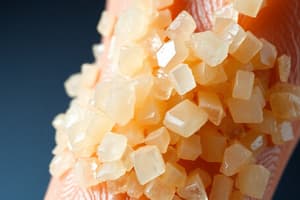Podcast
Questions and Answers
What is the role of a typical inflammasome?
What is the role of a typical inflammasome?
- Suppression of leukocyte recruitment
- Secretion of anti-inflammatory cytokines
- Activation of inflammatory caspases (correct)
- Inhibition of NFkB activation
What is the composition of a typical inflammasome?
What is the composition of a typical inflammasome?
- NLR, interleukin, NFkB
- NLR, adaptor protein, effector caspase (correct)
- Adaptor protein, NFkB, leukocytes
- Effector caspase, interleukin, leukocytes
What activates the release of IL-1b and IL-18 from pro-IL-1b and pro-IL-8?
What activates the release of IL-1b and IL-18 from pro-IL-1b and pro-IL-8?
- NFkB
- NLR
- Caspase-1 (correct)
- Leukocytes
What is the result of IL-1b secretion?
What is the result of IL-1b secretion?
How does intracellular IL-1b signal for inflammation?
How does intracellular IL-1b signal for inflammation?
What may act as a 'danger' signal to cells and result in the activation of inflammasomes?
What may act as a 'danger' signal to cells and result in the activation of inflammasomes?
What is the dominant source of urate in humans?
What is the dominant source of urate in humans?
Which transporter is best characterized for urate excretion?
Which transporter is best characterized for urate excretion?
What percentage of the filtered urate is excreted by the kidney?
What percentage of the filtered urate is excreted by the kidney?
What is the role of the transporter BCRP in urate excretion?
What is the role of the transporter BCRP in urate excretion?
What is the potential biologic effect of urate?
What is the potential biologic effect of urate?
What can hyperuricemia result in?
What can hyperuricemia result in?
Which of the following is a normal reference range of uric acid in human blood?
Which of the following is a normal reference range of uric acid in human blood?
What is the main route of urate elimination from the body?
What is the main route of urate elimination from the body?
What is the role of uric acid in damaged cells?
What is the role of uric acid in damaged cells?
What is the normal molecular weight of uric acid?
What is the normal molecular weight of uric acid?
What are the risk factors or causes of hyperuricemia?
What are the risk factors or causes of hyperuricemia?
Where is uric acid synthesized from in the body?
Where is uric acid synthesized from in the body?
Which of the following is a demonstrated effect of elevated urate levels in patients with CKD stages 3-5?
Which of the following is a demonstrated effect of elevated urate levels in patients with CKD stages 3-5?
What is the correlation between serum urate levels and worsening renal function, independent of other factors?
What is the correlation between serum urate levels and worsening renal function, independent of other factors?
What did a retrospective study of 12,751 CKD patients show about achieving a target serum urate of < 6 mg/dL in CKD stages 2 and 3?
What did a retrospective study of 12,751 CKD patients show about achieving a target serum urate of < 6 mg/dL in CKD stages 2 and 3?
What did the randomized trial of febuxostat in asymptomatic hyperuricemia patients with stage 3 CKD find?
What did the randomized trial of febuxostat in asymptomatic hyperuricemia patients with stage 3 CKD find?
In a study comparing allopurinol and febuxostat versus standard of care in CKD stage 3 patients with hyperuricemia, what did the febuxostat group show compared to the standard of care group?
In a study comparing allopurinol and febuxostat versus standard of care in CKD stage 3 patients with hyperuricemia, what did the febuxostat group show compared to the standard of care group?
What is a factor influencing MSU crystallization?
What is a factor influencing MSU crystallization?
Which transporter is responsible for the basolateral transport of urate in the proximal tubule?
Which transporter is responsible for the basolateral transport of urate in the proximal tubule?
What is the serum urate concentration defining hyperuricemia?
What is the serum urate concentration defining hyperuricemia?
Which of the following effects has been associated with higher serum urate levels?
Which of the following effects has been associated with higher serum urate levels?
What has been speculated as a potential mechanism through which elevated serum urate may contribute to cardiovascular disease?
What has been speculated as a potential mechanism through which elevated serum urate may contribute to cardiovascular disease?
What has been demonstrated in patients with chronic kidney disease who were administered allopurinol?
What has been demonstrated in patients with chronic kidney disease who were administered allopurinol?
What has been associated with lowering serum urate in patients with either asymptomatic hyperuricemia or gout?
What has been associated with lowering serum urate in patients with either asymptomatic hyperuricemia or gout?
Which protein is responsible for basolateral urate transport in the proximal tubule?
Which protein is responsible for basolateral urate transport in the proximal tubule?
What is the ATP-binding cassette transporter involved in renal and gastrointestinal urate excretion?
What is the ATP-binding cassette transporter involved in renal and gastrointestinal urate excretion?
What effect has been suggested for SGLT2 inhibitor in relation to urate transport?
What effect has been suggested for SGLT2 inhibitor in relation to urate transport?
What is the definition of hyperuricemia?
What is the definition of hyperuricemia?
What are elevated serum urate levels linked to?
What are elevated serum urate levels linked to?
What has been shown to decrease cardiovascular risk and slow the progression of renal disease?
What has been shown to decrease cardiovascular risk and slow the progression of renal disease?
Flashcards are hidden until you start studying
Study Notes
Effects of Elevated Urate and MSU Crystals in Chronic Kidney Disease
- Elevated urate levels in patients with CKD stages 3-5 are associated with endothelial dysfunction, vascular smooth muscle cell proliferation, increased IL-6 synthesis, elevated systolic blood pressure, and lower glomerular filtration rate.
- Serum urate levels > 7 mg/dL correlated with worsening renal function independent of age, gender, race, diabetes, hypertension, alcohol use, smoking, lipids, and baseline renal function.
- Retrospective study of 12,751 CKD patients showed that achieving a target serum urate of < 6 mg/dL in CKD stages 2 and 3 was associated with a 30% higher likelihood of eGFR improvement.
- In vitro, ex vivo, and some clinical studies have shown the effect of urate lowering on kidney function, but there is limited prospective evidence of intervention and slowing the progression of CKD.
- Randomized trial of febuxostat in asymptomatic hyperuricemia patients with stage 3 CKD found no significant difference in eGFR slope compared to placebo, but the placebo group only had a 1% decline in eGFR.
- Study comparing allopurinol and febuxostat versus standard of care in CKD stage 3 patients with hyperuricemia showed that the febuxostat group had significantly lower mean serum urate, higher mean eGFR, and longer renal survival time free from disease progression.
- MSU crystallization depends on urate concentration and other factors, such as increased concentration, decreased temperature, and local factors promoting nucleation and crystal growth.
- Only a fraction of hyperuricemic patients develop clinical gout, and some patients have normal serum urate levels during acute gout attacks, indicating a complex relationship between serum urate level and MSU crystallization.
- Urate levels decrease during an acute gout attack, possibly due to the uricosuric effects of inflammatory mediators and hormone production.
- MSU crystals activate an inflammatory cascade in leukocytes, leading to the production of IL-1 and IL-18, and cause the release of reactive oxygen and nitrogen species, resulting in necroinflammation.
- Crystal-induced inflammation involves the release of stimulatory molecules, fueling the recruitment of innate immune cells into the synovium and surrounding soft tissue, mediated by pattern-recognition receptors.
- MSU crystals, along with other crystal types, can cause direct cytotoxicity and inflammation-driven cytotoxicity, referred to as necroinflammation.
Urate Transport and its Clinical Relevance
- URAT1 is a crucial apical urate exchanger in the proximal tubule, playing a key role in urate homeostasis physiology.
- The URAT1 protein is encoded by the SLC22A12 gene, and GLUT9 (SLC2A9) is responsible for basolateral urate transport in the proximal tubule.
- ABCG2 is an ATP-binding cassette transporter involved in renal and gastrointestinal urate excretion, handling diverse compounds.
- Organic anion transporters (OAT) significantly impact urate retention and elimination from the kidney.
- Recent studies suggest a potential uricosuric effect of SGLT2 inhibitor, indicating urate transport across SGLT2.
- Gut eliminates 20-30% of urate daily in healthy individuals, yet the mechanism of extra-renal urate elimination remains unclear.
- ABCG2 contributes to intestinal urate excretion, emphasizing direct intestinal secretion as a factor in urate elimination.
- Hyperuricemia is defined as serum urate concentration >6.8 mg/dL, with gout prevalence rising with increases in serum urate.
- Higher serum urate levels are linked to increased risk of diabetes, metabolic syndrome, elevated BMI, hypercholesterolemia, hypertriglyceridemia, and insulin resistance.
- Elevated serum urate levels are associated with adverse cardiovascular effects, including hypertension, cardiovascular and cerebrovascular events, heart failure, and multiple mechanisms of cardiovascular disease.
- Lowering urate levels with allopurinol has been shown to decrease cardiovascular risk, slow the progression of renal disease, and reduce the risk for cardiovascular events.
- Elevated urate levels are associated with hypertension, and lowering serum urate with xanthine oxidase inhibitors and uricosurics has been shown to decrease blood pressure.
Studying That Suits You
Use AI to generate personalized quizzes and flashcards to suit your learning preferences.



